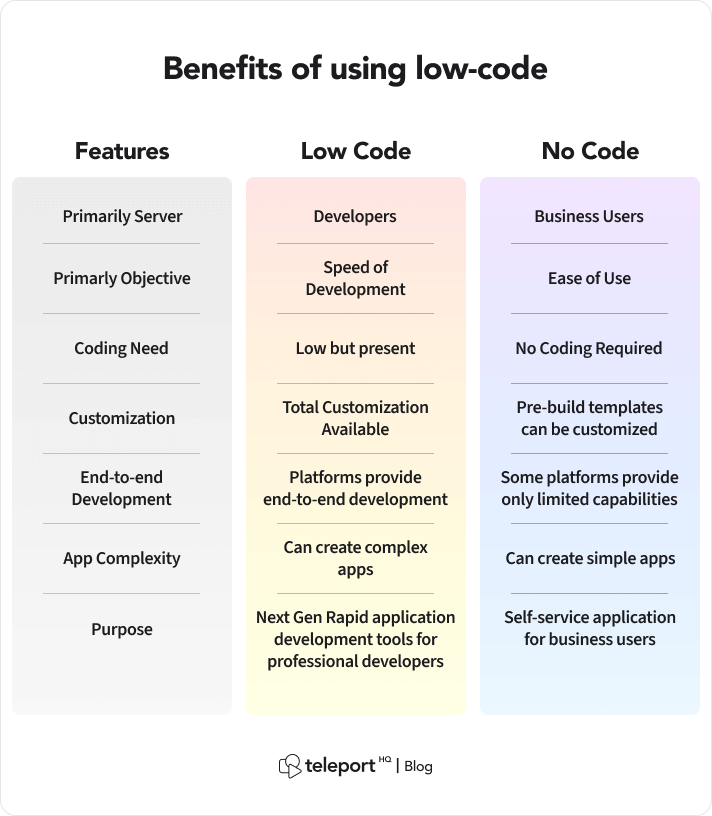Handy Facts For Deciding On Low-Code Platform Examples
Wiki Article
App Development Using Low-Code Is More Efficient.
Visual Development Environment :
Drag-and-Drop Interfaces: Low-code platforms provide visual tools for designing applications. Developers can utilize drag-and-drop tools to quickly assemble applications without having to write a lot of code.
Many low-code platform come with pre-built templates and components. This lets developers quickly develop or prototype their applications, without having start with a blank slate.
Reducing Coding requirements
Automated Generated Code: Lowcode platforms write the underlying code, based on the visual models developed by developers. This reduces manual coding, and accelerates the process of development.
Reusable component: Developers can use the same components for various projects. This cuts down time spent on testing and writing code.
Collaboration Streamlined:
Low-code development platforms are typically equipped with tools such as version control, deployment and testing. This allows for seamless collaboration across teams.
Citizen Development: People who are not developers and business users can use user-friendly interfaces to aid in the development of applications, which reduces bottlenecks caused by a lack of available professional developers.
Rapid Iteration, Prototyping
Rapid Prototyping Developers can swiftly create prototypes of ideas that can be validated and feedback to be gathered which results in faster iteration.
Easy Modifications. The visual nature of low-code development makes it easy for users to update and modify their software.
Pre-built Integrations:
API Integrations. A lot of low-code platforms have connectors that are designed to work with the most popular APIs and other services. This will speed up the process of integrating systems.
Data integration: Tools to integrate data are built in to simplify the process.
Scaling and Deployment:
One-Click deployment: Many platforms that use low-code offer a one-click option for deploying applications, thus reducing the amount of time and effort.
Cloud-based Solutions: Cloud platforms with low-code enable developers to focus on the design and function of their applications, rather than worrying about the logistics of deployment.
All in all, low-code development offers the advantage in terms speed due to its ability of automatizing and simplifying a variety of elements of development. This allows for faster delivery of apps and easier adaptation to evolving needs. See the top Low-code Platform for application development blog for site info including low code development platforms, app modernisation, application modernisation, cloud software applications, driver jdbc, app modernisation, cross platform mobile development, mobile development platforms, rapid applications, microsoft azure sql and more.

Cost-Effectiveness Is Among The Many Benefits Of Creating Applications Using Low-Code.
The low-code approach to app development is a cost-effective option that offers many advantages. It's an excellent choice for businesses looking to increase their budgets as well as create top-quality applications. The main advantages:
Fewer Coding Requirements: Low codes platforms remove the need for lengthy, hand-coded applications. Developers will spend less time and effort developing apps. This results in lower labor costs.
We require less developers: Development that is low-code takes shorter time, and it is simpler. This means that less developers are needed. It could reduce hiring and staffing costs.
Speedier Time To Market
Accelerated Development: Low-code platforms include visual development tools, pre-built components, and other tools that allow rapid development of software. Businesses can bring their products to market faster. This can result in quicker revenues and better position in the marketplace.
Rapid prototyping allows businesses to develop and test prototypes within a short period of time, which decreases the amount of time needed for the development phase. This allows them to make faster prototypes after receiving feedback from users.
Reduce the cost of maintenance
Because of their modularity and standard components, applications built on low-code platforms tend to be more simple to maintain. This helps reduce maintenance and support costs.
Automated Updates Many low-code platforms are capable of handling updates and patches in a manner that's both secure and timely. This means there is no requirement to manually intervene.
Efficient Resource Utilization:
Contributions by non-developers: Low-code platforms allow non-developers, like business users, to participate in the process of development. This democratization in development lets employees and businesses work together, thus reducing dependence on developers who earn high salaries.
Optimized Use of IT Resources: IT departments are able to focus on more strategic initiatives instead of getting bogged down by routine tasks of development which can increase overall productivity and efficiency.
The Scalable Pricing model
Subscription-Based Pricing: Many low-code platforms provide flexible, subscription-based pricing that can scale in line with the amount of the amount of usage. This lets businesses align their spending with their needs and future growth, avoiding large upfront expenses.
Pay-As-You-Go Options: Some platforms provide pay-as-you-go options, ensuring that companies only pay for the resources they utilize, which can be particularly beneficial for startups and small businesses with limited budgets.
Reduction in Third-Party Software Costs:
Low-code platforms usually come with functions that are integrated, eliminating the need to purchase extra tools or software. This could save you money on subscriptions and licensing fees.
Pre-Built Integrations: The availability pre-built intiations with popular services and systems reduces the need for custom-designed development. Time savings and money.
Improved ROI:
Faster Return On Investment: The combination of speedy development and lower costs with a faster time to marketing will allow businesses to earn higher return on investment.
Enhanced agility. Companies can adapt quickly to the ever-changing market conditions and customer requirements. This helps them remain relevant, and can take advantage of any new opportunities.
Low-cost Training:
User-Friendly Interfaces: Low-code platforms offer intuitive and easy-to-use interfaces that reduce the time required to learn.
Accessible Resources: A lot of platforms using low-code provide extensive training materials, tutorials and community support. This eliminates the requirement for formal education as well as the costs associated with it.
Collaboration can be made easier.
Enhanced Collaboration Tools: Built-in tools for collaboration aid in better coordination and communication between team members, resulting in improved development efficiency and a reduction in project costs.
Unified Development Environment. A single unifying software development environment can simplify processes and decrease the cost and complexity of managing different software and platforms.
In general, low-code apps are cost-effective due to their ability to cut costs for maintenance and development as well as to speed time-to-market, to optimize resource usage, and to provide flexible pricing. This combination of factors offers companies significant financial advantages and makes low-code an appealing option for companies seeking to make the most of their budgets for development, while still achieving robust and adaptable applications. Have a look at the top read this post here for site advice including jdbc server, develop mobile application, app platforms, rad application development, push notifications android, driver jdbc, multiplatform mobile app development, ms azure sql, cross platform mobile development, mobile app development platforms and more.

The Advantages Of Low-Code Development For Workflow And Collaboration
Low-code application development is a good option for companies looking to boost team productivity by streamlining development processes. Here are the top benefits: Improved Cross-Functional Collaboration:
Unified Development Environment : Low-code platforms provide a single, unified environment where all team members are able to work effectively including designers, business analysts, and other stakeholders. They eliminate silos and encourage better communication.
Visual Development Tool: The drag-and-drop nature of platforms using low-code allows team members who are not technologically inclined to participate in the development process. They are able to ensure that business requirements are precisely analyzed and implemented.
Communication Enhancement
Real-Time Collaboration: Many low-code platforms have real-time collaboration capabilities like the simultaneous editing of comments, and instant feedback. These features allow for continuous communication and decrease the amount of time that is spent in back-and-forth conversations.
Shared workspaces: Teams are able to work together in shared workspaces, in which they edit and discuss project elements. This will ensure that everyone is working towards the same goal and is on the same level.
Streamlined Workflow Management:
Integrated Project Management Tools: A lot of low-code platforms come with integrated tools for project management that can help teams track and plan their development projects. This includes tasks management, progress tracking and deadline management.
Workflow Automation - Automating repetitive tasks or workflows allows teams to concentrate their energy on more strategic projects and activities, improving the overall efficiency of the company.
Speedier Iteration Cycles
Rapid Prototyping Low-code platforms are perfect for rapid prototyping. Iterative development is also possible and allows teams to experiment, create and refine their applications in shorter times. This allows feedback to be integrated quickly and improvements can be made.
Agile Development Support The support for agile methodology lets teams work in sprints, continuously delivering small increments of functionality. This makes it easier to respond to changing requirements.
Accessibility of Non-Developers
Citizens Development: Lowcode platforms permit people who use business software (citizen developers) to design as well as modify and maintain applications with no programming expertise. This eases the burden on IT and development teams and can provide faster responses to the business demands.
Training and onboarding. Intuitive tools and extensive training resources help new team members to get their feet wet and increase the overall level of collaboration.
Centralized Documentation and Knowledge Sharing
Documentation integrated: Low-code platform features often allow you to make and manage documents inside the platform. All project information is centrally accessible and easy to access.
Knowledge Repositories : Teams can build knowledge repositories that include templates, best practices, and reusable components. This allows for sharing of knowledge and reduces duplication of efforts.
Consistency & Standardization
Standardized components: A standardized components, built in advance, ensures uniformity in applications. Team members can comprehend and work more easily on different parts.
Governance and compliance: Integrated governance frameworks help ensure that development conforms to regulations and standards of the organization. This decreases the chance of noncompliance, and helps applications meet quality standards.
Feedback loops:
Integrated Feedback Mechanisms Low-code platforms usually have integrated feedback mechanisms, allowing users to easily give feedback to applications. This can later be integrated into the process of development.
Continuous Improvement: The capacity of quickly iterating and deploying modifications based on feedback assures that applications are constantly developed, while being in tune with the goals and needs of users.
Visualization of Reporting
Real-Time Analyses: Built-in reporting and analytics tools provide immediate insight into project's performance, development and user interactions, making it possible to make data-driven choices.
Visual Workflow Maps Tools for mapping workflows or processes are helpful for teams to understand their workflows. They can also identify bottlenecks, and areas that need improvement.
When it comes to collaboration, low-code software is an excellent way to simplify workflows, bring different teams together, and automate tasks. This leads to a more collaborative, agile, and efficient development environment that leads to more efficient and high-quality applications.
